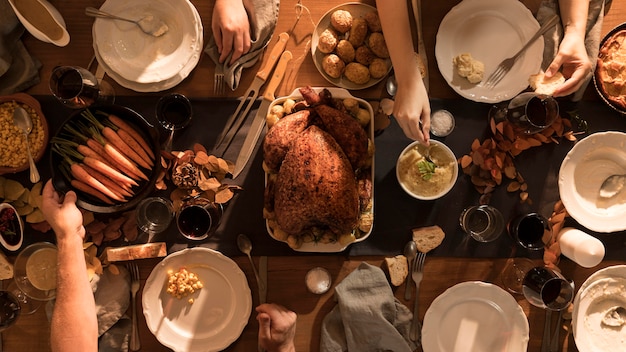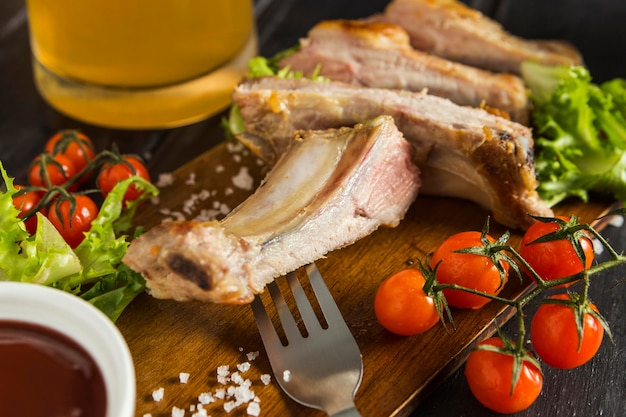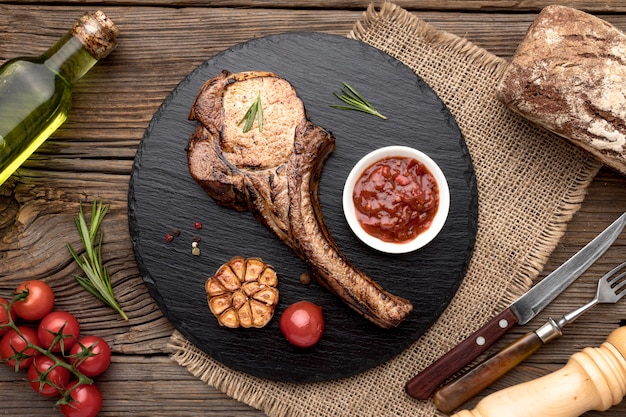(Part 1) The Hunt: A Day in the Woods

I'll never forget the thrill of that first successful hunt. The crisp autumn air, the crunch of fallen leaves underfoot, and the feeling of anticipation building as I crept through the woods. Every sense was heightened, my heart pounding in my chest. Then, there it was - a majestic buck, grazing peacefully in the dappled sunlight.
It was a moment of pure instinct, the years of practice culminating in a single, decisive action. The shot was clean, the buck fell quickly, and I felt a mixture of elation and a profound respect for the creature I had taken. I knew then, right there in the woods, that I had a responsibility to do this animal justice. To use every part, to honor its life, and to prepare it with the utmost care.
(Part 2) Field Dressing: Respecting the Harvest

Field dressing is a crucial part of the process. It's not just about practicality, it's about respect. The first thing I do is make sure the animal is dead, a check I never skip. Once confirmed, I begin by gutting the animal, removing the intestines and internal organs. I do this as quickly and efficiently as possible, taking care not to puncture the intestines or contaminate the meat. It's a bit of a messy job, but essential.
Next, I remove the hide. This is a bit of a chore, but it's essential for getting the best quality meat. I use a sharp knife and work carefully, taking care not to damage the meat underneath. I've learned over the years that a steady hand and a sharp blade are your best friends in this process.
(Part 3) Butchering: The Heart of the Matter

You can have your deer butchered professionally, but I prefer to do it myself. It's a rewarding process, and it allows me to control exactly how the meat is cut. It's a bit of a skill, but with practice, it becomes second nature.
I start by separating the legs and the backstrap. These are the most prized cuts of meat, perfect for roasting. Then, I remove the tenderloins, those long, thin muscles found along the spine. These are incredibly tender and flavorful, and I often cook them separately.
3.1. The Cut: Roast or Steaks?
For this guide, we're focusing on a roast, but here's a quick breakdown of other cuts you might encounter:
- Roast: This is the most common way to cook venison. The roast is typically made from the backstrap, which is a lean and flavorful cut of meat. It's a classic for a reason.
- Steaks: You can cut steaks from the backstrap, tenderloin, or even the leg. These are a great option for grilling or pan-frying. Perfect for a quick and satisfying meal.
- Ground Venison: The less desirable cuts of meat can be ground into venison burger. It's a flavorful and versatile option for dishes like burgers, chili, and meatballs. You'd be surprised how much flavour this seemingly "lesser" cut can offer.
(Part 4) Aging: A Touch of Patience
Aging venison is optional, but I highly recommend it. It's like letting the meat mature, allowing the flavors to deepen and the texture to soften. It's a bit like letting a fine wine breathe. Aging is simple. Just wrap the meat tightly in plastic wrap and store it in the refrigerator for 5 to 7 days. The longer you age it, the more tender and flavourful it becomes.
(Part 5) Preparing for Cooking: The Art of Seasoning
I like to keep my seasoning simple, letting the natural flavour of the venison shine through. But, a few key additions can elevate the dish to new heights.
5.1. The Essentials
Before I even think about seasoning, I trim any excess fat from the roast. Then, I rub the meat with salt and pepper. This simple step will lock in the moisture and enhance the natural flavour. It's a base that allows the other flavours to sing.
5.2. Adding Depth
To really give the roast a flavour boost, I add a combination of herbs and spices. I love using garlic, rosemary, thyme, and a pinch of cayenne pepper. The key here is to use these ingredients sparingly, allowing them to enhance the natural flavour, not overpower it.
5.3. A Final Touch
My secret weapon? A drizzle of olive oil. This helps to create a nice crispy crust on the roast and brings out the flavours even more.
(Part 6) The Roast: A culinary journey
The best way to cook a venison roast is in the oven, but the method depends on the size of the roast and your preferred level of doneness. It's all about finding what works best for you.
6.1. Low and Slow
My go-to method is low and slow roasting. I preheat the oven to 325 degrees Fahrenheit (160 degrees Celsius) and then roast the venison for 1.5 to 2 hours, or until it reaches an internal temperature of 135 degrees Fahrenheit (57 degrees Celsius) for medium-rare. This method results in incredibly tender meat with a rich flavour, and it's my go-to for large roasts.
6.2. High Heat
If you prefer a quicker cook, you can roast the venison at a higher temperature, around 400 degrees Fahrenheit (200 degrees Celsius). This will reduce the cooking time, but it's important to keep an eye on the roast to prevent overcooking. This method is great for smaller roasts or if you're pressed for time. Just remember to check the temperature regularly!
6.3. Resting: Key to Success
Once the venison is cooked, let it rest for at least 15 minutes before carving. This allows the juices to redistribute, resulting in a more flavorful and tender roast. It's a simple step, but a crucial one for a perfect roast.
(Part 7) Serving: A Symphony of Flavours
Venison pairs beautifully with a variety of sides. My personal favourites are roasted vegetables, mashed potatoes, and a simple green salad. And a good bottle of red wine complements the rich flavour of the venison perfectly. Think about what you like and let your imagination run wild!
(Part 8) Leftovers: The Art of Transformation
Leftover venison is a gift, not a problem! You can slice it thinly and serve it cold on sandwiches, toss it into a hearty stew, or even use it to make venison tacos. It's a chance to get creative and explore different flavours and textures.
(Part 9) FAQ: Your Venison Questions Answered
9.1. How do I know if venison is cooked properly?
The best way to check if venison is cooked is to use a meat thermometer. Venison should reach an internal temperature of 135 degrees Fahrenheit (57 degrees Celsius) for medium-rare. Overcooked venison can be tough and dry. So, always check the temperature!
9.2. What if the venison tastes gamey?
Gamey flavour is a characteristic of venison. If you find it too strong, try marinating the meat in a mixture of acidic ingredients like red wine or lemon juice before cooking. This will help to break down the proteins and reduce the gamey taste. It's a simple trick that can make a big difference.
9.3. How long can I store venison in the freezer?
You can store venison in the freezer for up to 6 months. Wrap the meat tightly in plastic wrap and then in freezer paper to prevent freezer burn. It's best to freeze it in portions for easier use later.
9.4. What are some other ways to cook venison?
Apart from roasting, you can cook venison in a variety of ways, including grilling, pan-frying, and even smoking. Just adjust the cooking time and temperature based on the cut and method you choose. There are endless possibilities!
9.5. Where can I buy venison?
You can buy venison from a butcher, a local farmer, or online retailers. If you're in the UK, there are a number of online shops specializing in venison. Ask around your local area and you might be surprised at what you can find.
(Part 10) Conclusion: A culinary adventure
Cooking a delicious deer roast is a journey. It starts in the woods, where you connect with nature and respect the animal you've harvested. It continues in the kitchen, where you bring your skills and creativity to transform the raw meat into a culinary masterpiece. And it culminates at the table, where you share the fruits of your labour with loved ones. It's a truly rewarding experience.
So, embrace the challenge. Learn from your mistakes, celebrate your successes, and above all, enjoy the process. Because cooking a venison roast is about more than just food, it's about connection, tradition, and the timeless art of preparing a meal that nourishes both the body and the soul.
Everyone is watching

Prime Rib Roast Cooking Time Chart: Per Pound Guide
Cooking TipsPrime rib roast. Just the name conjures images of lavish dinners, crackling fires, and hearty laughter. It’s ...

How Long to Bake Potatoes in the Oven (Perfect Every Time)
Cooking TipsBaked potatoes are a staple in my kitchen. They're incredibly versatile, delicious, and surprisingly easy to m...

Perfect Rice Every Time: The Ultimate Guide to Cooking Rice
Cooking TipsAs a self-proclaimed foodie, I've always been a bit obsessed with rice. It's the foundation of countless cuisi...

The Ultimate Guide to Cooking Asparagus: Tips, Techniques, and Recipes
Cooking TipsAsparagus. The mere mention of this spring delicacy conjures up images of vibrant green spears, crisp and burs...

Ultimate Guide to Cooking the Perfect Thanksgiving Turkey
Cooking TipsThanksgiving. Just the word conjures up images of overflowing tables laden with delicious food, the scent of r...
